As people become more health conscious than ever, the personal training market has seen a steady growth of 2-4% in North America and in the UK during the last 5 years.
And it's not just personal training that has experienced this growth. All areas of the fitness industry are booming:
- Sports nutrition
- Exercise clothing
- Personal training
- Nutrition coaching
- Fitness equipment
- Group fitness classes
So it’s safe to assume that getting into personal training or the fitness industry right now is a good move, but it can still be a difficult one.
Despite increasing consumer demand for fitness services, competition is more fierce than ever. Companies like GO Mammoth who offer all around employee wellness plans, corporate sporting events, fitness classes and inter-company sports leagues are also competitors, albeit in-direct.
Personal trainers need to ensure they are mindful of such competitors as well as direct competition from personal trainers both on and offline.
Just like in any industry, to carve out a successful career or create a profit-earning PT business, you’re going to have put in the hard work. But...
What if I told you there was a way to capture new clients for your business by doing something 99% of other trainers are not doing?
Heck, 99% of people don’t even know what it is...
And that thing is SEO (Search Engine Optimization).
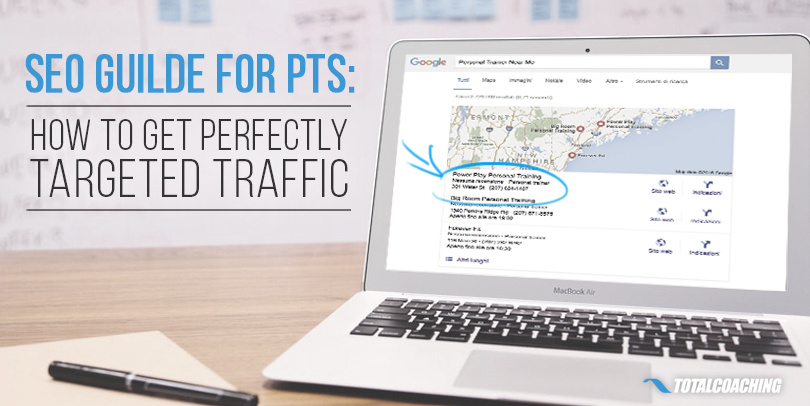
Why You Need to Think About Search Engine Optimization (SEO)
You see, to get new clients as a personal trainer, everyone thinks hyper-locally. New trainers start working at a local gym and recruit friends and family as their first clients.
Over time, if you do a good job people will start recommending you and you’ll pick up new clients, thereby growing your business.
Sounds like a solid plan, right? As simple as this sounds, it’s NOT the only thing you should be doing. Here's why:
Most PTs have a high churn rate. This means that some of your existing clients are going to stop training with you (even if you're an amazing PT!), which means you will never have a full roster unless you're constantly marketing your services.
What does this have to do with SEO?
SEO is a huge industry. Companies pay millions annually to be ranked on the top of Google search. Being ranked on the first page of a Google search will help drive people to their site, and hopefully these visitors become paying customers.
As a personal trainer, you need to become a BRAND. You need to think like a big company, constantly building your authority, recognition, and reputation.
Why You Must Become a 10X #Brand - https://t.co/mrgoX9Tkci - By Eric Enge @stonetemple pic.twitter.com/2K86dXJTve
— darren_mccowan (@darren_mccowan) June 11, 2016
But how?
The most important marketing activity you can undertake is creating free content on your website and social media platforms. This content offers value to potential clients and helps them remember YOU as someone who really know what's they're talking about.
Building your reputation and authority is just part of the equation though. We're talking about SEO, and SEO is all about capturing search engine traffic.
Just think about how powerful Google has become:
There are over 100 billion searches conducted on Google every month. Google is where research starts - You don't search for something online, you "Google it!"
We can safely assume that when people look for a new personal trainer they will conduct a quick google search to see what comes up.
Let’s look at a search done for personal trainers in Cardiff:
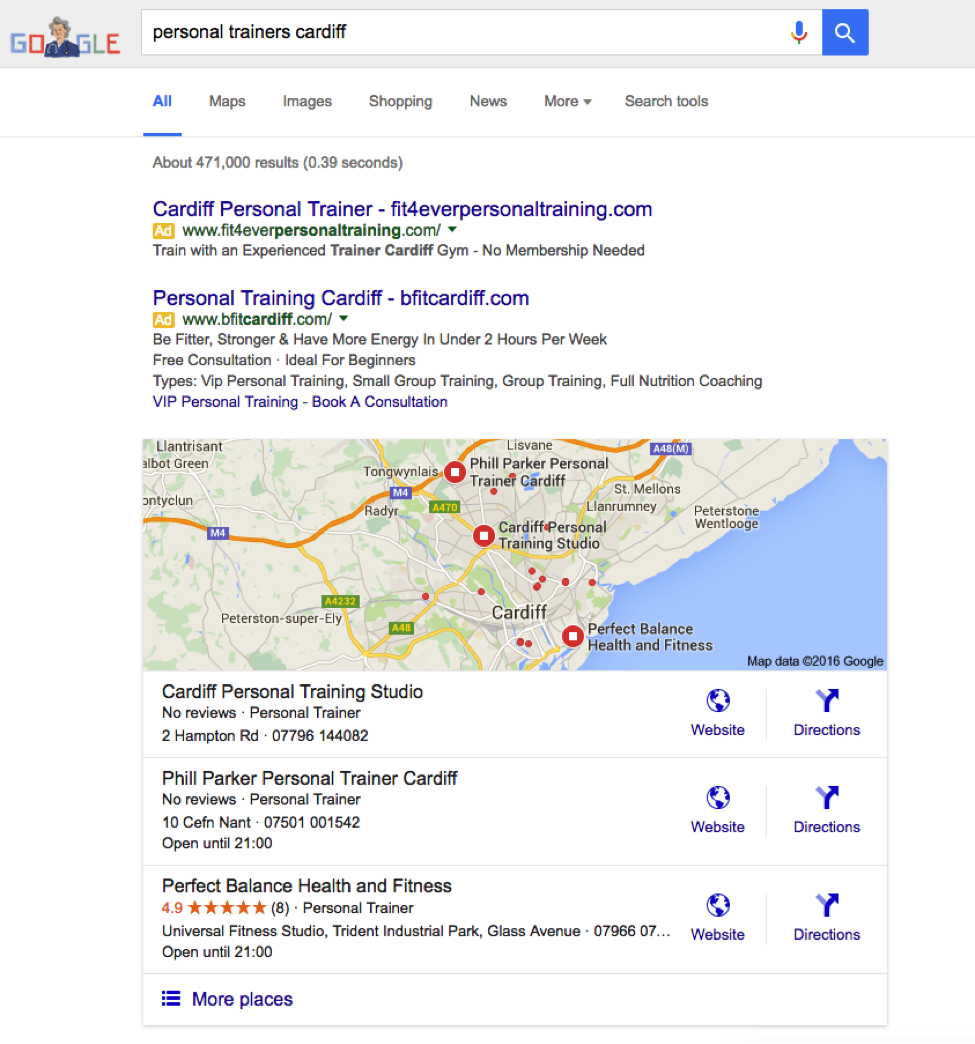
As you can see, Google shows 2 Google ads and then the local PT options.
Google will take information from websites, Google My Business accounts, and other citations they trust to determine which options show up first. The stars also represent Google reviews about each personal trainer.
In this example, Cardiff Personal Training Studio and Phil Parker are losing out on customers.
Why?
They have no reviews. Customer reviews are key.
Before you buy from any new website, brand, or shop, wouldn't you want to check out their reviews first?
You're not alone. About 77% of people read online reviews before going ahead with a purchase and 88% of people trust online reviews as much as personal recommendations.
I guarantee that Perfect Balance Health and Fitness will get a much higher CTR (click through rate) than the 2 options listed above him/her. This is purely due to the 8 reviews with an average score of 4.9/5. Those ratings sure are convincing!
What have we learned so far?
It’s vital your business shows up on the first page of a Google search for personal trainers in your local area. You also want to have at least a few reviews so that prospective customers trust you before they even know you.
In this SEO guide, I've covered exactly how to do that. Make sure you read and act on these steps so you’re fully visible in local Google searches.
But, it doesn’t end there...
Do What Other PTs Aren't Even Thinking About: Boost Your SEO
Under the local search results (i.e. the map displaying various PT options) are the organic search results. These results are non-ads and to get within the top 3 you need to be proactive about your website's SEO.
Many people skip the mapped search results and look directly to the organic results.
60% of all organic clicks go to the top 3 organic search results https://t.co/vJfFUBk568 #seo #search pic.twitter.com/kLFQmEkplT
— TweetGrowSocial (@TweetGrowSocial) June 20, 2016
In fact, 45% of clicks on the search result page will go to the top 2 organic results and 60% go to the top 3 spots. This means you really do need to be featured in the top 2 organic results in Google to gain any considerable traffic.
"But I already post on Facebook and Instagram. Isn't that enough?"
Social media is a super powerful tool and you can easily attract new customers and showcase results on Facebook, Instagram, Twitter, Snapchat, etc.
However, what most people don’t realize is that the volume of people who could be attracted to your business via search engines FAR outweighs any traffic you can generate with social media. Remember, there are more than 100 billion searches each month... Facebook can't touch that!
Organic search also has a far higher sales conversion rate when compared to traffic attained via social media. When people search in Google, they are often looking to buy something. You want these ready-to-buy prospects!
#SEO vs. #SMO: Driving Traffic Through Search Engines and Social Media
— Kanchana Rajalingam (@Kanchana_) March 28, 2016
> https://t.co/PBnLkVj35q#DigitalMarketing pic.twitter.com/jH3LRMFJZV
The following SEO guide is going to show you how to attract new clients from a channel that other PTs are not even thinking about. This is your chance to really stand out and make a name for yourself in the crowded fitness industry.
I’m going to give you a blueprint that will help you rank in Google search results, therefore drawing in hundreds of new daily visitors who will hopefully become paying customers.
Ready?
Let's do this!
Step 1: Set Up Your Website & Create Amazing Content
I’m not going to show you how to set up a website here (you can do it easily via WordPress for less than $100), but I am going to show you how to optimize your site to generate traffic every day.
For Google to rank you on their search results pages, you need a few fundamental things in place:
- A website that is structured correctly (on-page SEO)
- A website that has great content (on-page SEO)
- A website with links pointing to it from credible sources (off-page SEO)
- A website that answers a search query (also known as keywords)
When setting up your site, your homepage should be optimized for your most important keyword (more on that in a moment).
A web page is made up of the elements seen below. Refer to the picture below for the placement of each element:
- Content (Paragraphs)
- Page Title (Meta Title)
- Headings (H1, H2, H3 with H1 being the most important)
- Page URL (the shorter the better)
- Images (Add an "Alt Tag" to describe what the image is, Google cannot read images)
- Keywords (add your target keyword in the content + related keywords to help Google identify what the page is about. Your target keyword should also be in your meta title, H1 tag, and within the first 100 words of content)

Each page on your website must have the above structure to ensure it’s optimized for Google. So, if you have 5 different search terms that you want to be found for, you need 5 optimized pages (one for each term) to attract Google.

Meta data is the data that actually shows up in the Google search results page as shown in the image below. It doesn’t actually show up on your web page (only on the browser tab like in the picture above).
Once you have the structure set, you then need to focus each page for a certain keyword.
Your homepage will be your focus keyword for local search.
For example, if you’re a Cardiff personal trainer you should have “Cardiff personal trainer” in your homepage title, meta data, H1 tag, and in the content.
Your home page should have written content about you, your services, some client success stories, videos, images, and more. This should be your main hub of information. It should also contain your address, number, name (business name), email, and any other relevant pieces of data.
Once you’ve done that, you then need to optimize your other pages on the website for other keywords. Other pages will usually be about your services and they will appear in the navigation menu. For example, you might have the following:
- Fat Loss
- Muscle Gain
- Contest Preparation
- Meal Plans
- Etc.
These pages should be optimized for that certain keyword with your location in the title. Adding the location makes it easier for you to rank for search queries such as “fat loss Cardiff,” “contest preparation Cardiff,” “muscle gain Cardiff,” etc. You will not rank for “fat loss” and “muscle gain” in Google since these terms are far too competitive, so adding your location is a good way to catch some searches done locally for these.
Now you should have a website that has all its pages focused on a certain keyword and optimised fully for Google.
The Real Traffic Driver: Your Blog
Your blog should be in your main navigation and will act as your hub for all the articles you write on topics related to personal training. This is where your amazing content will be posted and how you’ll drive a huge amount of traffic to your site.
Before you start writing on your blog, you need to do some keyword research and write strategically. What’s the point in writing an article on a topic that nobody is searching for?
4 Content Marketing Hacks to Speed Your #Blog Growth https://t.co/gobvcB7s6a #writing pic.twitter.com/NaVABv5TAL
— Blogwriter365 (@Blogwriter365) June 22, 2016
Here’s a mini guide on how to find topics to write about that have decent search volume and what to do after you hit the “publish” button:
Step 1: Find keywords (search queries or questions) that have enough volume so that if you did rank number 1 for that term, you would get traffic to your website.
Your best tool here is the Google keyword planner and/or SEMRush. Let me show you an example of what you should do with both of these tools...
I plugged in a few random keywords to the Google keyword planner:
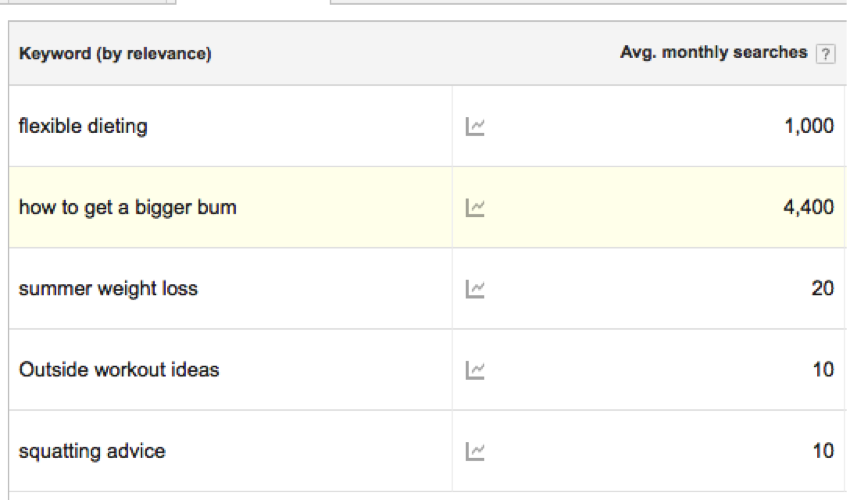
As you can see, the terms “Flexible Dieting” and “How to get a bigger bum” have 1,000 searches and 4,400 searches per month.
If you were to rank number 1 for both of these terms, you could theoretically be able to drive 5,400 people to your site every month (the number is usually lower due to click through rates and these numbers being estimates).
"Summer weight loss," "outside workout ideas," and "squatting advice" only bring in a total of 40 searches per month. This doesn’t mean you shouldn’t write an article on them - 40 people looking for advice on workout ideas, squatting advice, and summer weight loss could be 40 clients for you!
Don’t throw these away just because they are low volume terms, instead try and merge them into a single guide. A guide could cover summer weight loss by doing outside workouts. You could then add squatting advice to go along with this as part of the workouts you describe. You can target more than 1 keyword per article, but it’s recommended to stick to a main keyword first.
Optional Step: SEMRush is a SEO tool that’s for advanced marketers, but you don’t need to buy this.
If you did want some further insight into how hard it would be to rank number 1 for the search terms, then SEMrush gives you this data.

The difficulty % is ranked out of 100 and the higher this number, the harder it is to rank for this keyword.
For example, the term "flexible dieting" is given a 64%, which means that there is moderate competition for this search term.
"Summer weight loss" comes in at 80%, therefore it would be far more difficult to rank for. And with a search volume of only 30 it may not be the best option to target.
Now that I've seen this data, I might re-think my previous statement where I recommended making a bigger article covering the smaller keywords. "Summer weight loss" is just too competitive and offers too little traffic potential. I'd skip it altogether.
I know this is getting technical, but it's all very important. Hopefully you’re still with me here!
To simplify this, put in some article ideas you have into the Google keyword planner. Check the volume per month each keyword and prioritize them by preference.
Pro Tip: If you’re going to choose “flexible dieting,” you can drive extra traffic by doing the following:
Add terms like “2016” and “Guide” to the article title. This gives you more search terms to rank for such as “Flexible dieting 2016” or “flexible dieting 2016 guide”.
Pro Tip 2: Use Buzzsumo to search for articles that are already popular on the internet. It shows you how many social shares and links they have.
Read the articles and see if you can do better. If you can, replicate the article and improve on it. From there, you simply promote it and you should get the same amount or more traction.
Take a look at a search for “flexible dieting” in Buzzsumo:
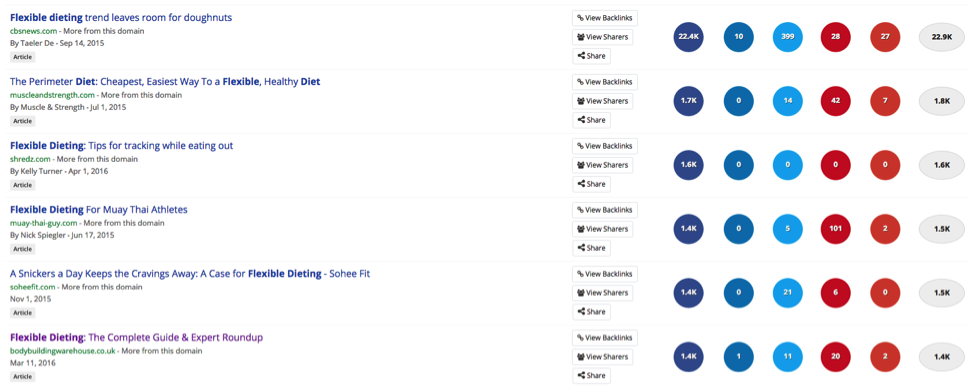
The 6th result is an article on flexible dieting I wrote for Bodybuilding Warehouse. Buzzsumo is a goldmine for finding content that performs well on the web.
Step 2: Promotion/Outreach
If you’ve read a few articles on SEO you may have come across people who claim links are dead and they have no place anymore.
Don’t listen.
Links are king and you need links pointing to your site to rank in Google for your target search terms. Having links point to your site is like having a vote for your website.
Think about it.
If you have a link (or vote) from a huge site like the BBC, then Google would consider you a quality resource. If you have 100's of votes (links) from spam sites with no relevance, Google will treat you the same and you won’t be shown in the search results.
The goal is simple: Get as many links from high quality and relevant websites as possible.
A high number of quality links + great content that’s structured and optimized for SEO = Top rankings.
It sounds easy, but here’s the biggest mistake most people make:
They publish their great quality content, post it on their social media, and sit back and wait.
They think that writing the content is enough. But, if you’re not actively promoting your content to people who can share it with their audience and link to it from their own website, then it’s worth nothing. Create content for industry influencers. You want to make sure that people who yield true power in the industry can easily share it and link to it.
Analyze the industry for trends.
I noticed a huge trend in the talk about flexible dieting, so I acted on it. I didn’t sit back and hope an industry expert like Layne Norton picked up my flexible dieting article. I emailed him prior to the article being published, asking him for a quote on flexible dieting. I then told him I’d send him the link once live.
What happened? He liked the content and shared it on his social media.

The results? 3,723 visitors in ONE day. Over 10,000 visitors since it went live. Now the 2nd most viewed page on the entire website.

The graph below shows the spike in traffic the day it went live. A great piece of content promoted to the right people will have dramatic results. This is your aim when creating content.

If you can create pieces of content like this each month, it will not only drive 1000's of visitors to your site, but with all the new links and shout outs from industry experts, you’ll be seen as an authoritative figure in the industry. This will do wonders for your personal training business and your Google rankings.
It’s not enough to just be a personal trainer anymore. You need to become a brand that’s trusted and wins clients online and off.
Step 3: Turning Visitors into Paying Customers
Here’s a step I see a lot of people miss...
You’ve built a great site. You've optimized it for on-page SEO. You've found a topic with a lot of search volume that's hot in the industry. You write an EPIC piece of content and promote it to the influencers. You get 50+ links, 1000's of visits and now rank number 1 in Google. You sit back and nothing happens. Just some nice stats on your screen.
I’ve had this happen to me. I learned the hard way.
The secret ingredient missing is building your email list.
My biggest regret in online marketing to date is being slow at starting to build my email list. Your email subscribers are worth 8x more than random website visits. You can send offers, content, and personal invites directly to their inbox. What could be better?
So what’s the best way to capture all this traffic into email subscribers?
What’s a content upgrade?
Check out my rugby training guide & e-book below. The article is huge!
It’s nearly 10,000 words and I thought the best way to get all these visits into an email subscriber list was to offer the entire post as an e-book so people can read it offline and wherever they want, whenever they want.
Content upgrading is simple. For my visitors to download the e-book, all they have to do is give me their name and email, then bam, they get the e-book sent directly to their inbox.
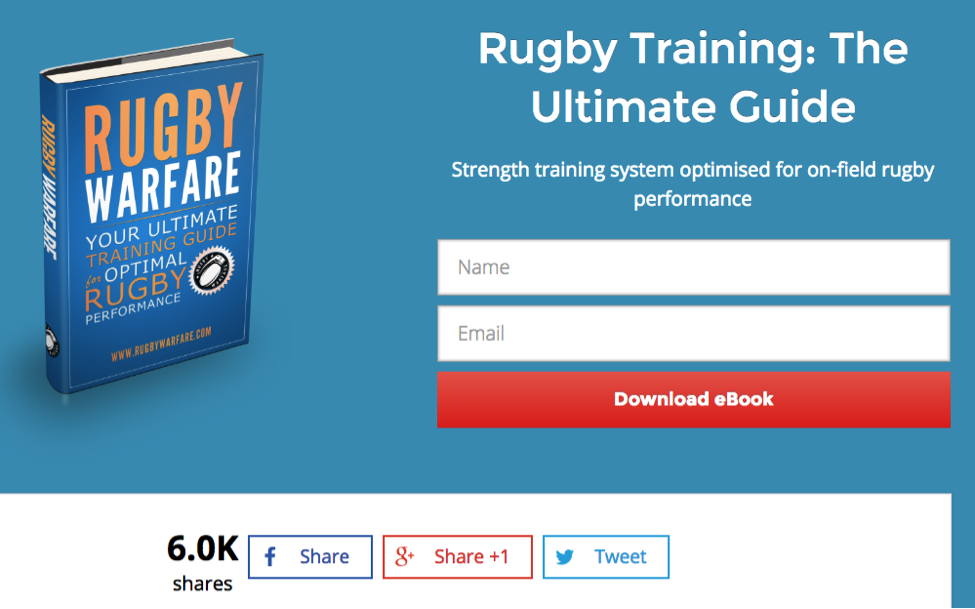
Here’s the article page for the e-book. I have the call to action at the top and the article below. This page has a 25% conversion rate (i.e. 25% of people who see it will enter their information to be able to download it).
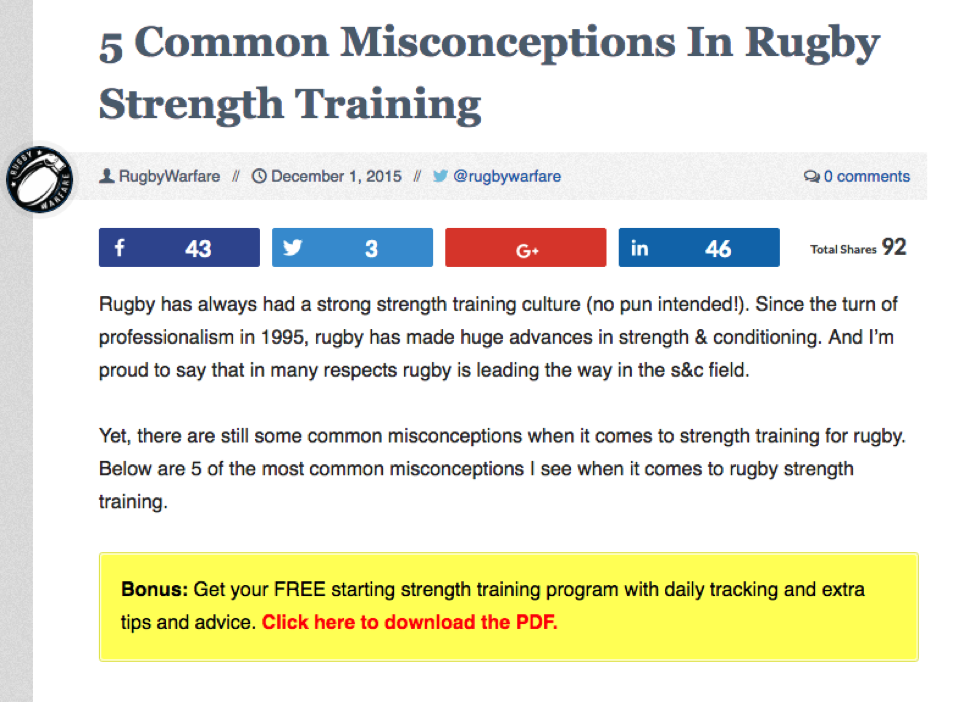
I then applied the same strategy across certain blog posts like below.
This is just an article about strength training, but I’m offering my free strength training PDF as a content upgrade.
Once they click the “Click here to download the PDF” a pop-up box appears like below:

Note: I’ve added the testimonial to increase the conversion rate. A simple email input box would suffice.
You can apply this strategy to all your blog posts. A content upgrade could be as simple as the article in a PDF format or “5 extra bonus tips not in this article.”
Be creative and see your email list grow 10 fold in weeks.
SEO Guide For Personal Trainers: Conclusion
The above blueprint should give you enough direction to start on the path towards online success.
You can utilize this online traffic to become an online coach and generate extra income without going to the gym to trade your time for money. More and more PTs are now going online and offering their services via email and Skype. This cuts down your costs, generates more profit, and gives you more freedom.
You should definitely be looking to online services to your arsenal of revenue generators as it allows you to move more clients online or convert online visitors into real life clients.
If you have any questions, please comment below and I’ll answer them all.




